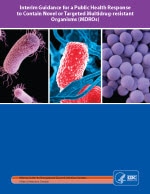Interim Guidance for a Health Response to Contain Novel or Targeted Multidrug-resistant Organisms (MDROs)

This document is intended for state and local health departments and healthcare facilities and serves as general guidance for the initial response for the containment of novel or targeted multidrug-resistant organisms (MDROs) or resistance mechanisms.
Print version: Interim Guidance for a Health Response to Contain Novel or Targeted MDROs[PDF – 10 pages]
General Recommendations
Healthcare facilities and laboratories should contact state or local public health authorities in a timely manner when targeted resistant organisms (e.g., pan-resistant organism) or mechanisms are identified (e.g., mcr-1 producing Enterobacteriaceae).
Health departments should be aware of the expanded capacity for antimicrobial resistance-related laboratory testing through the Antimicrobial Resistance Laboratory Network (e.g., screening cultures). When testing is indicated, health departments should contact the laboratory for their region directly to discuss the availability of specific testing and to coordinate specimen submission.
Health Departments conducting these investigations may consult with CDC by contacting the healthcare outbreak duty officer at haioutbreak@cdc.gov.
Goals of prompt response and containment should include:
- Identifying if transmission/dissemination is occurring
- Identifying affected patients
- Ensuring appropriate control measures are promptly initiated/implemented to contain potential spread
- Characterizing the organism or mechanism in order to guide further response actions, patient management, and future responses
Response Tiers
The following describes three different categories of organism (Tiers 1-3) and the recommended approach to each. General definitions of each Tier are included below; however, the organisms included in each Tier may vary by region depending on the local epidemiology.
Tier 1 organisms:
Organisms in this group include those with resistance mechanisms novel to the United States (i.e., never previously or only very rarely identified in the United States) or organisms for which no current treatment options exist (pan-resistant) and that have the potential to spread more widely within a region. This category also includes organisms and resistance mechanisms for which reports and therefore experience in the United States is extremely limited and a more extensive evaluation might better define the risk for transmission. Examples of organisms in this category include vancomycin-resistant Staphylococcus aureus (VRSA).
Tier 2 organisms:
Organisms in this group include MDROs primarily found in healthcare settings but not believed to be found regularly in the region; these organisms might have been found more commonly in other areas in the United States. For these organisms information is available about how transmission occurs and the groups primarily at risk. Examples include carbapenem-resistant Enterobacteriaceae with novel mechanisms (e.g., New Delhi Metallo-β-lactamase), carbapenemase-producing Pseudomonas spp.
Tier 3 organisms:
Organisms in this group include MDROs targeted by the facility/region that are already established in the United States and have been identified before in the region but are not thought to be endemic; information is available about transmission. Examples include carbapenem-resistant Enterobacteriaceae producing Klebsiella pneumoniae carbapenemase in regions where these organisms are more regularly identified; if only rarely identified in the region, these should be considered Tier 2 organisms.
Response Recommendations by Tier
The components of the initial response will vary depending on the organism involved; click to expand each window below for recommendations for the expected response, containment and control for each group.





















.jpg)









No hay comentarios:
Publicar un comentario